Maximize Your Tiny Entryway with Smart Design Ideas
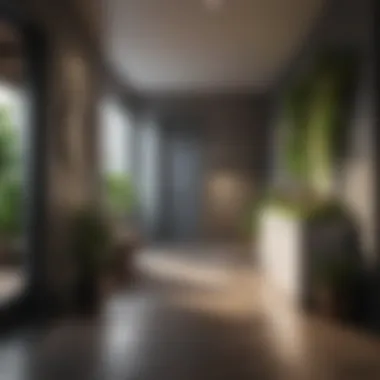
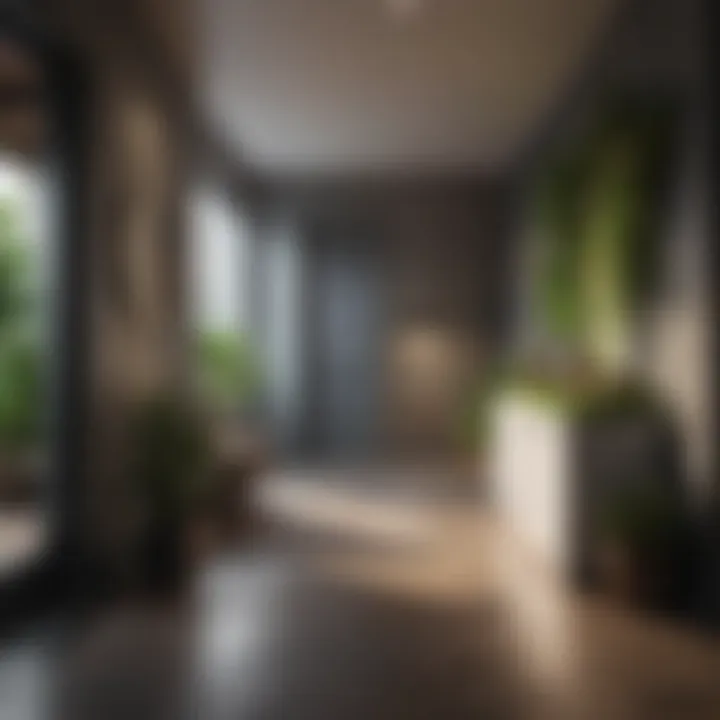
Intro
In today’s world, space is often a luxury that not everyone can afford. Many people find themselves living in smaller homes or apartments where every square foot counts. Entryways, often the overlooked threshold of our homes, are typically small, cramped, and sometimes lack functional character. But what if we could transform these tiny spaces into something truly remarkable?
This article will delve into innovative designs and strategies to maximize your compact entryways, ensuring they are both practical and stylish. From multifunctional furnishings to efficient storage methods, we will explore various elements that can enhance functionality without compromising aesthetics.
Design Inspirations
Creating a small entryway that serves its purpose and feels welcoming is entirely achievable. Let’s explore some trending styles and color palettes that can ignite your design journey.
Trending Styles
When it comes to design, the philosophy of less is more often shines brightly. Minimalism is a big player here, where clean lines and uncluttered spaces take center stage. The key is choosing furniture that doubles up on function. For instance, a sleek bench can serve as both seating and a spot to stow your shoes.
On the other end of the spectrum, a bohemian style introduces vivid textiles and layered textures. Look for funky wall hangings or colorful mats that invite people in while providing visual interest, creating that cozy European vibe.
Another compelling choice is industrial chic, which often incorporates raw textures. Think of using reclaimed wood and metal accents—perfect for an entryway that exudes both charm and toughness.
Color Palettes
Choosing the right colors can dramatically alter your entryway’s aura. Light shades, such as soft whites or pastel yellows, can create the illusion of space. They bounce light and make cramped quarters feel larger. Consider complementing those light hues with a splash of deep indigo or forest green to add depth and richness.
For homeowners craving a touch of drama, dark and moody colors can work wonders. Selecting a rich navy blue for the walls, paired with terracotta vases or bright yellow doors, not only adds personality but also generates a stunning contrast.
"When it comes to color in a small entryway, it's all about balance—dark and light elements should play nicely together."
Maintenance and Upkeep
Keeping your entryway functional means regular maintenance. But how do you effectively manage upkeep in tight spaces? Let's break that down into actionable steps.
Seasonal Maintenance Checklist
- Spring: Check for any mildew on the walls, and consider refreshing the paint. Spring cleaning is essential—donate items that just take up space.
- Summer: Organize your shoe collection; consider investing in box storage or decorative baskets to keep things tidy.
- Fall: Assess the decor. Is it time to swap in a fall-themed mat or bring out those autumnal colors?
- Winter: Protect your floors by placing an indoor mat to prevent mud and snow from lingering.
Cleaning and Organization Tips
- Regularly wipe down surfaces. Those small nooks tend to gather dust easily.
- Use vertical space to your advantage! Hanging coat racks can save valuable floor real estate.
- Invest in multifunctional hooks that not only store keys but even small bags or umbrellas.
- Every few months, reevaluate what you let in your entryway. It’s easy to accumulate items that clutter even the smallest of spaces.
To sum it all up, optimizing a tiny entryway can be both a fun and rewarding endeavor. By watching trends, manipulating space wisely, and maintaining organization, you can create a welcoming first impression that resonates with everyone who walks through the door.
Understanding the Importance of Entryways
Entryways are more than just places to enter or exit your home. They serve a significant role in shaping first impressions and setting the tone for the spaces that follow. In this article, we acknowledge how these small areas provide a unique opportunity to blend functionality with design. A well-considered entryway can reflect personal taste and showcase one’s lifestyle. Homeowners should treat this space with the importance it deserves.
Functionality vs. Aesthetics
When it comes to design, balancing functionality and aesthetics is akin to walking a tightrope. On the one hand, the entryway must perform essential tasks: it needs to contain shoes, bags, hats, and various items that constantly flow in and out of the home. On the other hand, it should also be visually appealing. A cluttered entry can lead to chaos, while an empty one may feel sterile.
- Functionality might involve choosing the right storage solutions, such as benches with hidden compartments or stylish hooks that blend seamlessly into the decor. This ensures that everyday items are easily accessible but out of sight.
- Aesthetics can emerge from thoughtful design choices. Selecting a captivating color scheme, striking artwork, or even a unique light fixture can create warmth and allure without sacrificing practicality.
Being mindful of both aspects will transform a bare entryway into a welcoming gateway.
Setting the Mood From the Start
The entryway is the very first impression guests get when they step foot in your home. As such, it acts like an opening act in a play—setting the mood for the performances that follow. To create a cheerful or calming atmosphere, consider elements like lighting, decor, and even the scents wafting from nearby candles or diffusers.
- Lighting plays a pivotal role. A dim, uninviting space can cast a shadow over the entire home, while warm and bright lighting can make the area feel more welcoming.
- Decorative touches should convey your personality. A family photo gallery can tell visitors who you are and what you cherish, while a collection of travel memorabilia can whisper tales of adventures past.
- Aromatic elements, like fresh flowers or scented candles, can further accentuate this feeling, wrapping visitors in an olfactory embrace as they enter.
"The entryway sets the stage, allowing guests to savor your home’s ambiance before they even step further in."
Ultimately, understanding the importance of entryways can turn an often-overlooked space into a delightful introduction to your home, showcasing your style while remaining functional. It's all about getting that balance just right.
Design Principles for Small Spaces
When we talk about maximizing tiny entryways, the design principles we apply to these limited areas carry great weight. It’s not just about filling up space; it involves creating a harmonious balance between functionality and visual appeal. Each inch is gold in a small entryway, and the choices you make can significantly impact both the flow and the feel of your home as one steps inside.

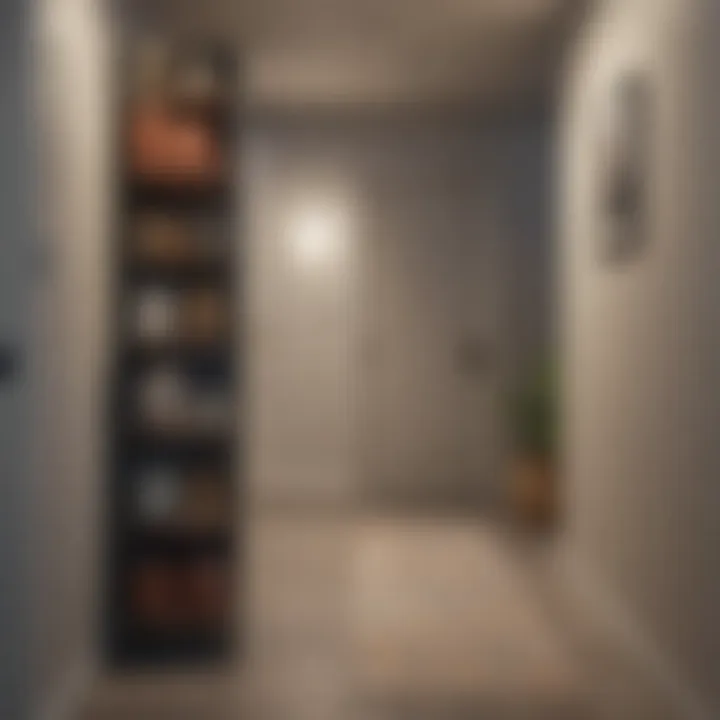
Incorporating intelligent design principles for small spaces allows you to craft an entry that feels spacious, organized, and welcoming, rather than cramped or chaotic. Focusing on key elements like light, color, and materials is essential. These elements can change how the area feels and can dictate how smoothly people move through your home.
For instance, using the right color scheme not only enhances the visual space but can also help set a calming tone right from the entrance. Likewise, the choice of materials determines not only durability but also the warmth of the space. All these factors considered together create a blueprint for designing a functioning and beautiful entryway, one that truly represents you and your home's personality.
Emphasizing Light and Color
Light and color are your best friends in a small entryway. Everyone knows that lighter colors can make a space feel roomier. Paint those walls a soft pastel like mint green or pale yellow, and you will immediately see a difference. Land your eyes on any shade that reflects light and lifts the mood, as it can open up the area, giving a deceptive impression of spaciousness.
Natural light is also a major component. If possible, maximize any windows or doors that allow sunlight to flood in. Using sheer curtains rather than heavy drapes is a must. Mirrors can work wonders too; placing them strategically will bounce light around the space, enhancing brightness.
"Light can not only make a room feel larger but can also guide your mood as you come home."
Consider incorporating ambient lighting as well, like wall-mounted lamps or recessed lights that don’t take up precious floor space. Accent colors can add touches of vibrancy and personality too. Using one bold tone alongside a more neutral palette, such as a dark blue bench or vibrant green plants, creates a cheerful atmosphere without overwhelming the senses.
Choosing the Right Flooring
Flooring may not be the first thing that springs to mind when conceptualizing a small entryway, but it’s vital. The right flooring can either expand or constrict the perception of space. Light-colored materials are again preferable; think of light hardwood or pale tiles. They help brighten up the environment while making the ceiling feel higher.
You might also want to steer clear of large patterns which can be distracting. Opt for smaller designs or solid colors that won't fight for attention when you first enter. Additionally, textures matter; perhaps consider wood laminate or polished concrete which not only looks fabulous but is also easy to maintain—very handy in high-traffic areas that time and weather can wear on.
When tiling, elongated rectangular shapes can create a line-of-sight that leads the eye deeper into the space, giving an illusion of depth in a compact area. Furthermore, rugs can help delineate spaces; they anchor furniture and make the area feel more inviting without taking up too much real estate. A stylish runner can guide anyone from the door to the next room while adding character.
In summary, crafting a tiny entryway into a comfortable and pleasing space is achievable through thoughtful design principles. Emphasizing light and color, coupled with the right flooring choices, creates an ambiance that is not only welcoming but also enhances the overall flow of your home.
Multifunctional Furniture Options
When it comes to maximizing a tiny entryway, the right furniture can be a game changer. Multifunctional furniture serves more than one purpose, making it invaluable in small spaces. For instance, a bench can provide both a place to sit and hidden storage underneath. This dual functionality not only optimizes the use of space but also enhances organization. Having a few smart pieces can make a cramped area feel more open and look aesthetic.
In this section, we'll tackle three standout options: built-in benches with storage, narrow console tables, and wall-mounted elements. Each piece contributes to a more organized and inviting atmosphere.
Built-in Benches with Storage
A built-in bench with storage is a remarkable solution for an entryway that lacks square footage. It can serve as a launching pad for your day. You can sit down to put on shoes, and with the lift of a seat, you’ve got ample space to store those unsightly boots or umbrellas out of sight.
Consider the materials and style of the bench; a wooden design can add warmth, while metal offers a modern edge. If you're feeling creative, paint the storage unit in a bold color to liven up the space. Just remember, it’s not only about aesthetics. Think how it can integrate seamlessly with your overall décor—functionality first!
Narrow Console Tables
Next on the list are narrow console tables. They might be small in stature, but their impact can be significant. These tables fit snugly against walls, offering a stage for decorative accents or key racks without blocking paths.
Opt for one with drawers or shelves to stow away mail or small items that tend to clutter surfaces. You could jazz it up with a stylish lamp or a mirror to create an illusion of depth. The key here is combining form and function—your entryway doesn't have to sacrifice one for the other!
"A narrow console table can be both a space-saver and a visionary piece that creates excitement as you enter your home."
Wall-Mounted Elements
Lastly, wall-mounted elements are a tremendous asset in maximizing vertical space. Floating shelves, for instance, can display shoes or personal items without taking up floor area. Hooks are another excellent addition; they provide a convenient spot for coats and bags, cleverly utilizing that often wasted wall space.
When selecting these wall elements, consider the color and material in relation to existing decor. Mixing different textures like metal with wood can bring an added depth and appeal. It's these small changes that can make a large impact on the efficiency of an entryway, ensuring that every inch counts.
With multifunctional furniture options, your tiny entryway can embrace a world of functionality while still looking chic and well-coordinated. By choosing smart pieces that cater to your needs, you'll create an entryway that is not only welcoming but also distinctly yours.
Smart Storage Solutions
When it comes to tiny entryways, smart storage solutions are not just beneficial; they are essential. These systems capitalize on limited space while keeping everything organized and accessible. In a place where first impressions matter, a tidy and functional entryway speaks volumes. Implementing innovative storage ideas can not only reduce clutter but can also promote a sense of peace and order right from the front door. This concept deserves a closer look, focusing on specific arrangements that harmonize practicality with design.
Vertical Storage Systems
Vertical storage may sound all business with not much flair, but it's anything but dull. Utilizing wall space might just be the golden ticket to transforming crammed quarters into an oasis of order. Wall-mounted shelves can hold everything from keys to decorative items, maximizing every inch of wall without infringing on floor space. Imagine a tall, sleek shelving unit that reaches up to the ceiling—not only does this create a visually striking feature, but it also draws the eye upward, giving the illusion of more height in the room.
Consider also the addition of pegboards or grid systems, which allow for adaptable storage solutions. You can change the arrangement based on seasons, special gatherings, or even just a change of mood. The versatility of vertical solutions means they can evolve alongside your needs.
Under-Bench Storage Options
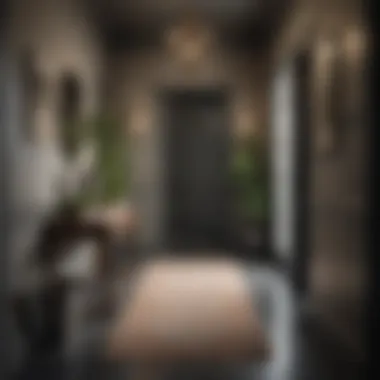
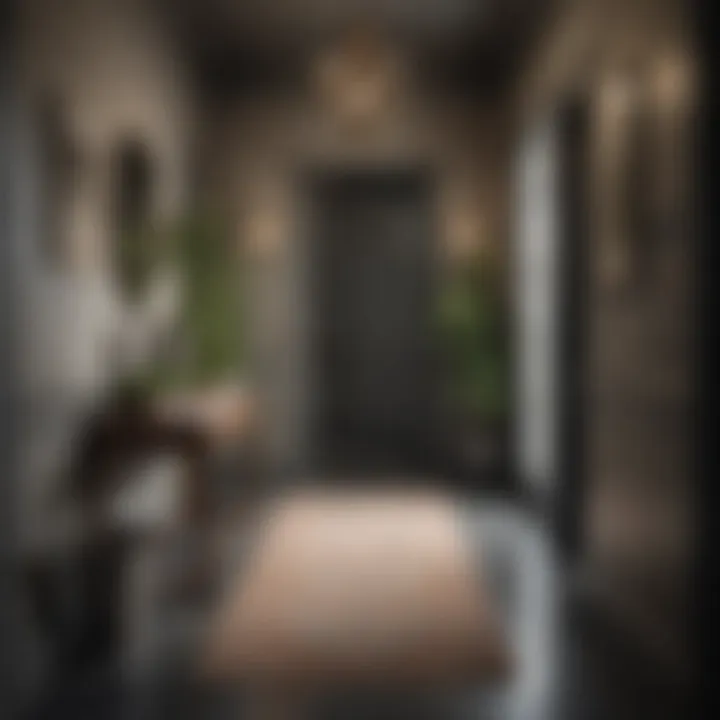
Another area worth exploring is the space beneath benches or seating arrangements. Those innocuous spots can be a treasure chest for anything from shoes to seasonal gear. Think of a built-in bench that not only serves as a resting spot but also features sliding drawers or cubby spaces underneath. This creates a convenient way to stow away items that could otherwise clutter the floor.
Even if you opt for standalone benches, choosing the right type can make a significant difference. For example, a bench with an open bottom can double as a shoe rack while still looking stylish. Alternatively, upholstered benches with hidden storage make for a cozy seating option that doesn't compromise on style or utility.
Creative Use of Hooks and Hangers
Hooks and hangers might seem simple but underestimating them would be a grave mistake. These are not just for jackets; they can serve as decorative elements that add character to your entryway. By placing hooks at varying heights, you can make them functional for both adults and little ones, ensuring every family member can contribute to keeping the space neat.
Think about decorative wall hooks that showcase your personality— this can elevate your entryway from bland to beautiful almost instantaneously. Additionally, multipurpose hangers, which hold bags, hats, or even umbrellas, can save floor space and encourage you to keep things off the ground.
Incorporating smart storage solutions truly transforms your entryway into a more functional and welcoming space, signaling to guests that they have arrived at a home that values organization and elegance.
By exploring these innovative ideas, you can redefine even the tiniest entryway into an inspiring first impression of your home, striking a balance between style and practicality like a finely tuned violin.
Choosing the right storage options not only enhances the look but also makes day-to-day living smoother, which is a goal worth pursuing in any living space.
Incorporating Natural Elements
In small entryways, incorporating natural elements can be a game-changer. It brings a slice of the outdoors inside, promoting a sense of calm and making the space feel more inviting. Not only do natural elements enhance the general aesthetics, but they also serve practical purposes, like improving air quality and creating a more comfortable atmosphere. A touch of greenery or the play of natural light can completely transform an entryway from mundane to vibrant.
Plants as Entryway Decor
Adding plants to your entryway is like breathing life into the space. Think about it—when you walk into a home and see a splash of greenery, it immediately sets a welcoming tone. There’s a variety of plants that work great in tight spots. For example:
- Pothos: This vine thrives in low light and can be trained to climb or cascade down walls.
- Snake Plant: It’s hardy, requires little maintenance, and purifies the air brilliantly.
- Air Plants: These require no soil and can be displayed creatively in various holders or hangers.
When selecting plants, consider their light needs and how they’ll fit into your entryway’s overall vibe. You can opt for a single larger plant that serves as a statement piece, or go for a collection of smaller pots that display a variety of textures and colors. Additionally, hanging plants can free up floor space and add dimension.
"A well-placed plant can be as striking as a piece of fine art, bringing personality and warmth to the entrance of your home."
Using Natural Light to Enhance Space
The way light enters an entryway can make or break its ambiance. Small entryways can often feel cramped and uninviting, but natural light can change all that. Here are a few smart ways to harness natural light effectively:
- Mirrors: A carefully placed mirror can reflect light, making the space appear larger and brighter. Choose a decorative mirror that compliments your home’s style.
- Light-colored Walls: Soft hues, like whites or light pastels, can bounce light and create an airy feel. It’s a straightforward trick that doesn’t require any heavy lifting.
- Transparent or Translucent Doors: If the opportunity arises, consider using glass doors or sidelights to allow light to pour into the entry.
- Strategic Placement of Windows: If you’re building or renovating, think about incorporating windows or skylights, designed to let the sunshine in from above.
Integrating natural light doesn’t just brighten the space but also connects it to the outside world. This can be particularly rewarding in an entryway, often seen as a transitional space between the exterior and your home’s interior.
Aesthetic Touches That Make a Difference
Aesthetics in a tiny entryway might not immediately spring to mind. However, it's crucial to grasp how these touches can enhance your space. A small area doesn't mean it can't pack a visual punch. In fact, carefully chosen elements can make a world of difference. They can project character, warmth, and a welcoming vibe, setting the tone for the rest of your home. People judge their surroundings within moments, so infusing your entryway with style not only beautifies but may evoke positive feelings. Here are some aspects to consider.
Color Palettes for a Cohesive Look
Selecting a color palette is a core aspect of achieving a cohesive look in your entryway. A consistent scheme can tie together various elements. For smaller spaces, lighter colors generally create an illusion of openness. Think soft whites, pale blues, or gentle greys, allowing light to reflect in the area. On the flip side, a darker palette could give a sophisticated feel, perhaps with rich navy or charcoal. The key lies in balance.
- Three-Color Rule: Try sticking to three complementary colors. For example, a soothing light grey, deep navy, and a vibrant mustard for an unexpected zest works beautifully.
- Bold Accents: Accentuate with bold colors through small details like a bright vase or a colorful plant pot. Just a hint can revive the dullest spaces.
- Textures and Patterns: Don't shy away from experimenting. Striped wallpaper or an intricate area rug can provide depth without overwhelming the area.
Artwork and Wall Decor Ideas
Wall decor plays a significant role in an entryway's aesthetics. It's a blank canvas that holds immense potential. Opting for artwork that resonates with you instills personality. You could hang a gallery of family photos or invest in some striking wall art. Choose pieces that spark joy or provoke meaning.
- Size Matters: In a tight spot, oversized artwork can create a statement, drawing the eyes upward and creating a sense of height. Conversely, a series of small frames can form a playful collage.
- Functional Art: Consider pieces that double as storage or a mirror. Mirrors are exceptional for small spaces; they can make a cramped entryway seem larger while also adding a decorative touch.
- Seasonal Displays: Rotate your decor with the seasons for added flair. During autumn, fill a basket with pinecones and pumpkins, and come spring, swap it out for birth flowers or greenery.
"Art enables us to find ourselves and lose ourselves at the same time."
Ultimately, it’s about making the entryway an inviting reflection of who you are. Each choice—color, decor, or design—should feel intentional. Embracing these aesthetic touches can elevate the experience of a tiny entryway, transforming it from an overlooked passage into a captivating invitation into your home.
Maintaining a Clutter-Free Environment
In any discussion about maximizing tiny entryways, maintaining a clutter-free environment steers the ship. A small entryway quickly becomes a chaotic mess if left unchecked. Oversized shoes cluttering the floor, bags haphazardly thrown aside, and various knickknacks can all contribute to a sense of disorganization and overwhelm. However, by embracing a clear strategy for decluttering and streamlining the space, not only is the entryway more functional, but it also sets a welcoming tone for anyone walking through the door.
An open entryway can promote positive energy and a sense of calm right from the get-go. A clutter-free space allows your guests to feel at ease and gives you a moment of respite after a long day. Imagine stepping through your door and being greeted by a serene nook instead of a jumbled pile of shoes and coats. This crucial aspect ties closely with the principles of minimalism by encouraging the idea that less is more. By removing excess items, you create a cleaner and more appealing environment that resonates with style and function.
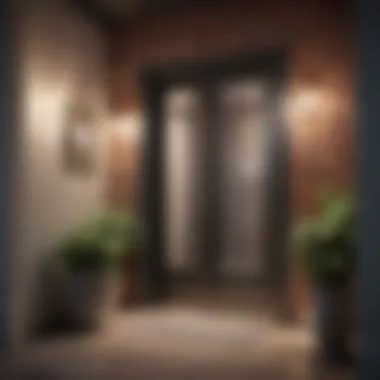
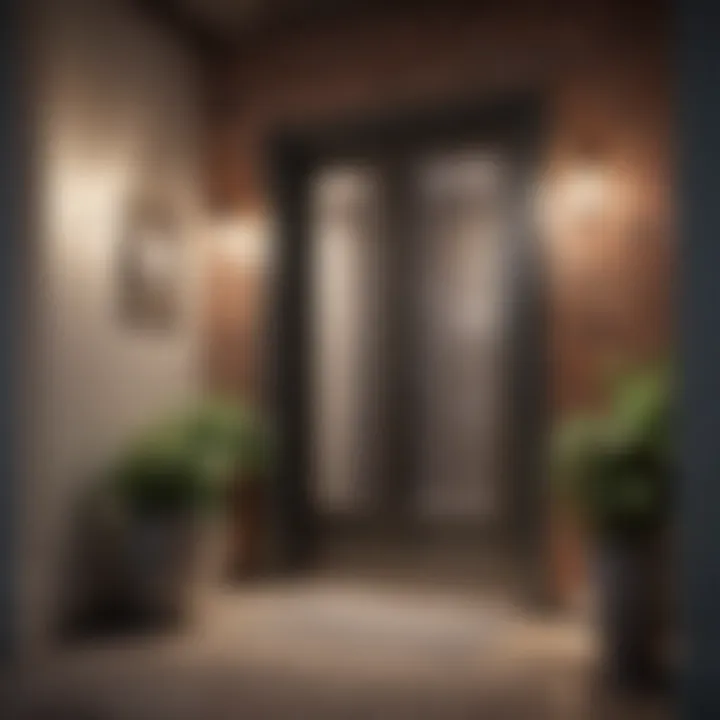
Decluttering Essentials
To embark upon the decluttering journey, it’s important to have a game plan. Here are a few essentials:
- Limit the number of items in your entryway: Each item should serve a purpose or hold sentimental value. For example, instead of displaying ten decorative pieces, consider showing just one or two favorites that truly capture your personality.
- Create designated zones: Establish specific areas for different items. A section for shoes, another for bags, and perhaps a spot for keys. By having a clear layout, family members and guests will have an easier time placing items down correctly.
- Regularly assess the space: Make it a habit to reassess the items in your entryway periodically. Change of seasons can spur new clutter, so take a moment to remove any winter boots as spring arrives, making way for lighter footwear.
- Utilize stylish storage solutions: Instead of hiding items in a cabinet, consider using decorative boxes or baskets. This way, everything has a home, but it doesn’t sacrifice the aesthetic appeal of the entryway.
As you declutter, remember that prioritizing functionality does not mean compromising style. The goal is to find a balance where beauty meets utility.
Creating a Routine for Upkeep
Once the clutter is cleared, establishing a routine ensures that the entryway remains a pleasant space. Some steps to incorporate into daily habits might include:
- A quick evening clean-up: Spend a few minutes each evening, tidying up your entryway. Put away shoes, hang up jackets, and clear clutter from surfaces. It takes only a short amount of time, yet it has a big impact on the overall appearance.
- Involve family members: Whether you live alone or with others, getting everyone on the same page can help a lot. Teach kids where to hang their coats and how to place their shoes neatly. This can also foster a sense of responsibility and ownership of communal spaces.
- Set reminders: Use phone apps or sticky notes to remind yourself of your entryway cleaning sessions. These prompts can keep your routines at the forefront, ensuring that nothing slips through the cracks.
- Monthly deep clean: Dedicate a day at the end of each month to tackle extra tasks. Dust surfaces, polish any furniture, and check for any items that have wandered out of their designated zones.
A clean entryway not only prevents clutter but also creates a warm invitation for anyone entering your home. Your entryway acts as the welcoming face of your living space, and a tidy appearance speaks volumes about the thoughtfulness of the home it leads into.
"A tidy entrance guarantees a warm welcome, making a statement before anyone even steps inside."
Engaging in these practices can transform a chaotic entryway into a harmonious area that reflects your tastes while being a bastion of organization. This combination positions your entryway as a seamless transition into the rest of your home.
Personalizing Your Entryway
When it comes to crafting a first impression, the entryway stands as the prelude to your home. Personalizing this small space is not just about aesthetics. It’s about creating an atmosphere that resonates with your values and lifestyle. Tailoring the entryway to reflect your personality transforms it from a mere pass-through to a warm welcome. This is particularly vital for spaces that may be tight and sparse, where every detail counts. It tells guests a bit about who you are, and sets the tone for the entire home.
Incorporating Personal Mementos
One of the most impactful ways to personalize your entryway is through mementos that have meaning. Be it travel souvenirs from a recent adventure or family photos that evoke cherished memories, these elements breathe life into an otherwise bland area. Arrange a small gallery wall that includes framed pictures of your loved ones or favorite landscapes. The arrangement doesn’t have to be formal; a playful, asymmetric layout often sparks curiosity and conversation.
In addition, consider using small shelves or shadow boxes to display treasured items. Maybe you collected seashells from a beach trip or have an artistic piece from a local market. Incorporating these bits gives the space character and depth. Not only does this provide a warm touch, it also offers a sense of comfort at the doorstep.
- Choose items that tell a story: More than decorative pieces, select mementos that have significance.
- Mix textures and materials: Different materials can create an interesting visual contrast. Wooden frames alongside metal sculptures can draw the eye.
- Consider practicality as well: Mementos that serve a function, like a coat rack from your last road trip, can be both useful and meaningful.
The Role of Scent in Entryways
Scent is often the unsung hero of home ambiance. The moment you step into a home, a pleasant fragrance can evoke feelings of comfort and belonging. Strategically placing scent elements in your entryway can elevate the experience. Think about welcoming scents that reflect your personality—perhaps fresh lavender for a calming touch, or citrus for an energizing vibe.
Utilize diffusers or incense that align with the mood you want to create. Alternatively, a potpourri bowl filled with dried flowers and spices can also do wonders. This not only adds a nice scent but also serves as a decorative element to the entry.
"The first thing people notice when they walk in is not just what they see, but what they smell."
- Natural options: Essential oils and beeswax candles are great for those looking for healthier alternatives.
- Seasonal scents: Switching scents with the seasons can keep things fresh and exciting. Think cinnamon sticks in autumn or fresh-cut grass in spring.
- Scented welcome mat: An unexpected yet effective method of leaving a lingering impression as guests step inside.
In summary, personalizing your entryway is both an artistic expression and a reflection of one’s life. By combining personal mementos and thoughtful scents, you create an inviting atmosphere that resonates with both you and your visitors. In tight spaces, where minimalism often reigns, these personal touches can break the sterility and showcase your unique identity.
Future Trends in Entryway Design
As time moves forward, it's essential to pay attention to how evolving styles and innovations impact our living spaces, especially entryways, which often set the tone for everything that follows. The subtle details of the entryway can transform a mundane welcome into a stunning statement. With so many people seeking to optimize their limited spaces, keeping an eye on future trends in entryway design allows homeowners not just to keep up, but also to elevate their home environment in ways they might not have considered.
Sustainability in Design
Sustainability in design isn't just a trend; it's a vital consideration for homeowners and designers alike. The push for eco-friendly materials has led to several innovations in entryway design. Using reclaimed wood for a striking bench or integrating recycled glass in decorative elements aids in minimizing waste and supports a circular economy.
Here are several factors to consider when opting for sustainable materials in entryway design:
- Durability: Always opt for materials that stand the test of time. This minimizes replacements and, thus, waste over the years.
- Local Sourcing: Choosing materials that are locally produced reduces environmental impact related to transportation, while also supporting local economies.
- Natural Finishes: Use water-based stains and paints to avoid harsh chemicals that can affect air quality.
Utilizing plants in your entryway not only adds freshness but also contributes to air purification. The gentle rustling of leaves helps create a calming atmosphere, making the first entry into your home feel less like entering a house and more like stepping into a snug retreat.
Technology Integration in Small Spaces
Embracing technology can immensely enhance the efficiency and atmosphere of your entryway. Smart home devices not only simplify daily tasks but also add a modern flair to your decor. Think about motion-sensor lights that illuminate the space as you walk in or smart mirrors that display the weather and your calendar while you get ready for the day.
Other innovative ideas for tech integration in small entryways include:
- Smart Locks: These offer convenience and security, allowing you to control access to your home without fumbling for keys.
- Charging Stations: Installing a discreet charging spot for your devices ensures that all your gadgets are powered up as you head out the door.
- Smart Shelving: Incorporate shelves with integrated lighting or alarm systems that alert you if you forget essentials like your keys or wallet.
"When technology and design come together, it can turn even the tiniest of spaces into functional masterpieces."
Furthermore, augmented reality can be utilized in designing your entryway by allowing homeowners to visualize how different elements fit together before committing to purchases. This can be especially beneficial for those in smaller spaces where trial and error can be more costly.
Ultimately, an eye on future trends in entryway design not only helps to maximize the functionality and aesthetic appeal but also aligns with evolving lifestyles and preferences, ensuring that the entryway isn’t merely a passage but a valued part of the home.







